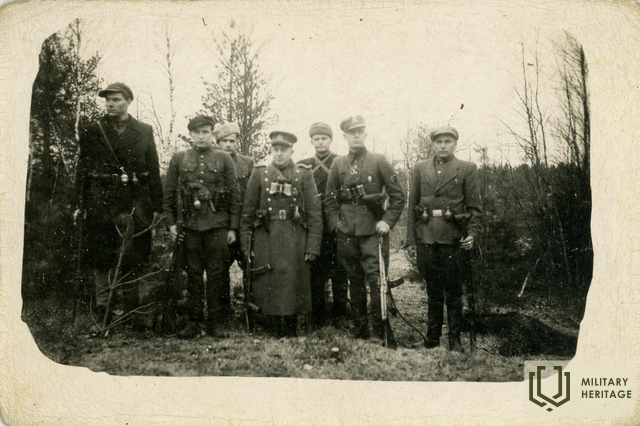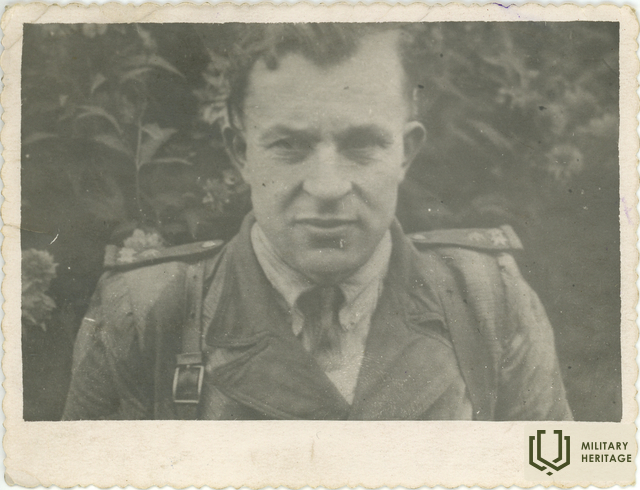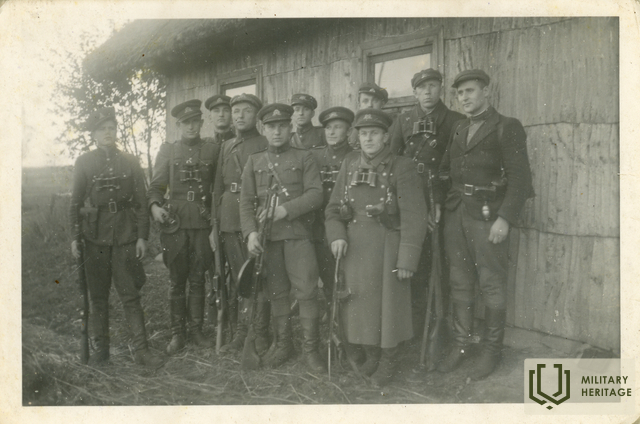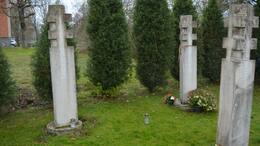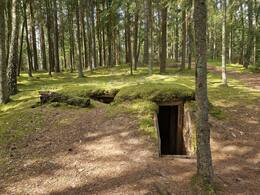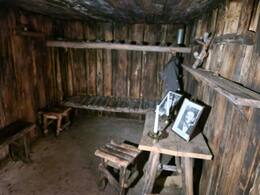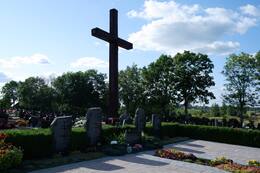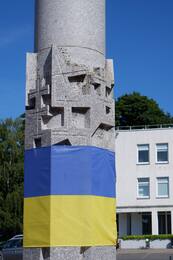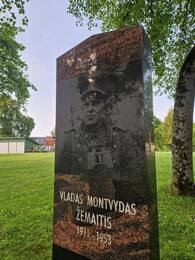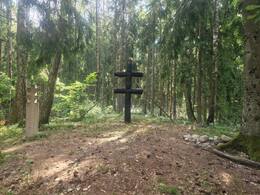Samogitian Partisan District
III National Partizans, IV Soviet Occupation
Samogitia Region – a Lithuanian partisan military territorial unit that operated in 1946-1953, fighting the Soviet occupation regime in Samogitia. The region operated in the territories of Telšiai, Kretinga, Mažeikiai and part of Tauragė counties. It was formed on the basis of the Lithuanian Freedom Army detachments – in April 1946, 10 detachments were formed in eight rural municipalities, which were merged into the Samogitia Legion. On April 17, 1946, this legion became the Samogitia Region.
The district consisted of three main detachments: Alka, Karda and Šatrija. The Alka detachment operated in Mažeikiai County in 1945-1949. It was formed by A. Narmontas (Ivanauskas), a member of the Lithuanian Freedom Army, from the companies of the Vanagai military organization. From October 1946, K. Venckus (Adomaitis) became the temporary commander, and from July 25, 1947, the permanent commander. By 1947, only the Seda, Ylakiai, Židikai and Viekšniai companies had the required number of members, the others operated as detachments. At the beginning of 1948, the Soviet security formed a special group of agent hitmen, which declared itself the Mažeikiai company. In January-April 1948, 60 partisans and supporters were arrested, and in August, agents destroyed the headquarters of the detachment, and the commander K. Venckus was also killed. In 1949, the team practically ceased to function.
The Kardas (Sword) detachment operated from 1945. November 15. - early 1953 in Darbėnai, Endriejavas, Gargždai, Kartena, Mosėdzis, Palanga, Plateliai, Salantai, Veiviržėnai parishes, Kretinga city and parish. The detachment was established by order of the commander of the Samogitian Legion of the Lithuanian Freedom Army J. Semaška (Liepa), and K. Kontrimas was appointed as the first commander. The partisans of the detachment fought actively - participated in several battles with the NKVD and security units, including the attacks on the town of Endriejavas (May 25, 1945 and 1950) and the capture of Veiviržėnai (June 7, 1948). The detachment published the newspapers "Laisvės aukuras", "Tiesos ir kovos keliu". During its existence, it had several commanders: K. Kontrimas, J. Ožeraitis, J. Kėkštas, J. Jucius, and J. Paulauskas.
The Šatrija detachment, which operated in 1945-1953, was the most important detachment of the Samogitian region. It was founded on August 1, 1945 on the basis of the Wolf detachment of the Samogitian Legion and operated in Telšiai, Plungė, Rietavas and other counties. In 1946-1947, the detachment consisted of 10 companies: Alsėdžiai, Janapolė, Luokė, Nevarėnai, Plungė, Rietavas, Telšiai, Tvera, Varniai and Žarėnai. In June 1948, the detachment was divided into 3 homelands, and at the beginning of 1953 there were 5 of them. The number of members of the detachment varied: in April 1946 it had about 200 fighters, in October 1946 and April 1947 - about 120, in September 1948 and 1949 - In January 1945 – about 110, in early 1951 – about 40, in late 1952 – about 20 fighters. The detachment was notable for its active actions: on May 10, 1945, it attacked Luokė, on June 24, 1946, near Luokė, it killed the operational representative of the Telšiai County Security Department and two guards, and on April 12, 1949, on the Telšiai-Nevarėnai road, it killed two junior lieutenants of the militia.
The district belonged to the Western (from July 1948 – Jūra) region. The first district commander was the chief of staff of the Samogitian Legion, F. Ašoklis (Vilkas), and A. Ruzgys (Margis) was appointed as the chief of staff.
During its existence, the district had several commanders: Jonas Semaška-Liepa (November 1945 - April 1946), "On the Path of Truth and Struggle" (April - September 1946), Kazimieras Antanavičius-Tauras (until April 1947), Kazimieras Juozaitis-Meteoras and the last commander - Vladas Montvydas-Žemaitis (1948-1953).
In September 1946, after the security forces arrested F. Ašoklis and B. Staliūnienė (Vyšnia), a crisis began in the activities of the district. The restored headquarters in Plungė rural municipality was headed by K. Antanavičius (Tauras) until April 1947, but on April 9, the headquarters was destroyed. With no staff members left, the district fell apart. The commander of the Šatrija squad, K. Juozaitis (Meteoras), and the commander of the Alka squad, J. Vygantas (pseudonyms Ivanauskas, Narmontas), who had disobeyed him, declared themselves leaders. The security forces provoked a conflict between them. J. Vygantas fell under the influence of the Joint Democratic Resistance Movement Committee controlled by the security forces, which was led by agent JA Markulis (pseudonyms Erelis, Ąžuolas). In 1947, In October, after traveling to Vilnius, J. Vygantas prepared declarations calling for an end to armed resistance. Samogitian partisan leaders condemned his treacherous behavior.
After the district collapsed, support was provided by the Kęstutis district led by J. Žemaitis (Vytautas). The Samogitian district headquarters was restored, with A. Milaševičius (pseudonyms Radvila, Ruonis, Vairas) as its commander, and V. Montvydas (pseudonyms Žemaitis, Etmonas, Algimantas, Dėdė) as its chief of staff, who later, from June 1948 to August 23, 1953, was the district commander.
The propaganda department was active in the district. The newspaper "Laisvės balsas" (published until April 20, 1953) was edited by I. Petkutė (pseudonyms Neringa, Vilnelė, Lakštingala). She also edited the newspaper "Malda giriojė" (1951-1952). The district partisan chaplain, the pastor of the Pašilė parish, V. Stirbys, until his arrest in April 1950, together with others, published and distributed the district headquarters newspapers. In 1952, a collection of poems "Laisvės kovų aidai" was published in a circulation of 1,000 copies.
The Samogitian region suffered huge losses: in 1947-1950. 624 partisans were killed, 1972 partisans, liaison officers and supporters were arrested. In 1952-1953. another 161 were destroyed, 49 were arrested, 4 partisans legalized. During that time, the partisans liquidated 37 security agents. The region ceased to exist in August 1953, after the death of commander V. Montvydas together with adjutant B. Alūza (Bedalis) and editor I. Petkutė. Printing supplies, a loom and many newspapers were found in their bunker. The last partisan of the region and one of the last Lithuanian partisans, Pranas Končius-Adomas, was betrayed and died on July 15, 1965 near Kūlupėnai.
More information sources
Related timeline
Related objects
Monument to the memory of the partisans of the Samogitian region who died in the Alsėdžiai area
The monument in the Alsėdžiai area is dedicated to honoring the fallen partisans of the Alka and Šatrija detachments of the Samogitian region, who actively fought against the Soviet occupation in the post-war years. The monument commemorates all those who defended Lithuania's freedom and independence in these areas, fighting against much stronger and better armed Soviet forces.
The monument was built to commemorate the fighters of the Alka and Šatrija divisions, who were buried in the trenches at this location between 1944 and 1953.
The monument consists of a composition of typical partisan memorial signs. The authors are designer Romas Navickas and architect Viktorija Molienė. The monument was unveiled on August 29, 2004, thanks to the efforts of Alfons Norkaus-Žilvičis, a former partisan of the Alka detachment of the Samogitian region, and a political prisoner.
Today, this monument is one of many that commemorate the partisan resistance in Samogitia and throughout Lithuania.
Educational trail in the Throne Forest with a partisan bunker and monuments
In 1947, partisans of the Žarėnai company of the Šatrija Unit, led by Edmundas Rekašius-Lakūnas, were stationed in the thicket of the Forest of the God of Thrones (Telšiai district). On 21 May 1949, during an operation by the KGB, a partisan camp was discovered, with 11 partisans in the camp at the time.
Seven partisans, including the commander of the Šatrija unit, Aloyzas Mažutis-Šarūnas, were killed in the exchange of fire. During the operation, four partisans were captured, and three of them – seriously wounded. Company commanders Edmundas Rekašius-Lakūnas and Steponas Rekašius-Darius managed to escape the siege. The burial places of the partisans killed in battle were determined by brothers Alfredas and Romualdas Jonušas, based on eyewitness testimonies and KGB documents. Nowadays, a cognitive trail has been developed at the Forest of the God of Thrones, where you can see the place where partisans died, the memorial cross, as well as the restored bunker where Zigmas Tomkus, the head of the operational division of the Šatrija Unit of Žemaitija County, lived and worked from 1947–1948, and where the partisans of the Šatrija Unit of Žemaitija County stayed in May 1949. While walking along the trail, you can see the restored partisan dugout of the Žarėnai Company, the place where a partisan, Irena BelazaraitėŽibuoklė, died, where a chapel has been installed, a cross with the surnames of the fallen partisans, a monument to the partisans of Žemaitija, and other memorial items.
Miliai (Krakiai) partisan bunker
About 1.5 km east of the Krakiai settlement, in the Jonuškis forest, on the right bank of the Kutuvys River, a former hiding place for participants in the post-war freedom struggle has been restored.
On January 3, 1948, betrayed by an MGB agent, two partisans died here after a heroic fight: 29-year-old member of the "Alka" squad, group leader Albertas Švažas-Vanagas, and 25-year-old Pranas Šiuipys.
In 1999, a small oak cross was erected at this location, and in 2005, a pillar in the shape of a Vytis cross was erected in the forest near the Kuršėnai–Mažeikiai road to commemorate those who died. In the same year, the remains of the partisans were reburied in the Viekšniai cemetery.
"When we started work, there was a heavily overgrown area with grass and birch trees. We started digging slowly, hoping to find the remains of the bunker's logs, but we didn't find them; all we found was a rusty grenade. We dug up two large stones and then it became clear that we were in the right place - according to witnesses, the bunker was between those stones, and partisans would jump through them to get inside to mislead uninvited guests," said P. Trakinis about the bunker's installation.
A drawing of the partisan bunker was found in archival documents, and the current bunker was reconstructed based on it in 2010. Its construction corresponds to the original drawing, but, according to contemporaries, it was "shallow", smaller in size, and built of logs.
Rietavas Region Partisan Memorial at Rietavas Cemetery
There is a memorial in the Rietavas cemetery dedicated to the memory of the partisans of the Šatrija, Kardas, and Darius teams of the Samogitian and Kęstutis counties who fought and died in the Rietavas area in 1944-1953, as well as their supporters.
In the Rietavas region, brutal repressions were carried out against partisans and their supporters during the Soviet era, and some fighters were arrested, tortured and finally killed. The bodies of many partisans, including those who fought in the Rietavas area, were secretly buried in forests or on the territory of the Rietavas manor. Soviet security structures hid their bodies in order to sever any ties with their struggle and intimidate the population. The remains of five partisans were accidentally found on September 23, 2010. on the territory of the Rietavas manor, during the restoration work of the Rietavas manor.
This memorial, consisting of a cross and monuments with the names of those who died, symbolizes the sacrifices made for freedom, and provides an opportunity to remember those whose sacrifices have long been forgotten or suppressed.
Monument "In Memory of the Partisans and Freedom Fights of the Samogitian Region"
The monument standing in Telšiai Independence Square is dedicated to the partisans of the Samogitian region and the Freedom Struggles. Interestingly, impressive monuments have been erected in various Lithuanian cities to commemorate the activities of the partisan districts that operated in that region.
Samogitian Region – a partisan region established in 1945 that united the participants of the Lithuanian resistance in Telšiai, Kretinga, Mažeikiai counties and part of Tauragė county. People of the Lithuanian Freedom Army had been very active in North-Western Lithuania since mid-1944, and the military tradition was very strong here. Fighters who did not belong to the LLA were accepted into the active and organizational sectors.
The district published the newspapers "Voice of Freedom", "Fighting Lithuanian", "Prayer in the Forest". It had three detachments - Karda, Alka and Šatrija. The district headquarters was destroyed on August 29, 1953. The last partisan of the district, Pranas Končius-Adomas, died on July 6, 1965.
The monument consists of a column on a pedestal with a relief composition of crosses in the lower part and inscriptions dedicated to the memory of the partisans. The author is the famous sculptor Regimantas Midvikis, who created many famous sculptures in various Lithuanian cities, including the monument to King Mindaugas in Vilnius.
Monument to Vladis Montvydas-Žemaitis
A monument to one of the partisan leaders, Vladas Montvydas-Žemaitis, has been erected in the town of Varniai, Telšiai district.
The monument was erected to commemorate the 60th anniversary of the death of the partisan commander of the Samogitian region, Vladas Montvydas-Žemaitis. On August 24, 2013, at the initiative of the Lithuanian Freedom Army (LLA) and its chairwoman Irena Montvydaitė-Giedraitienė, a granite monument was erected in memory of the last commander of the Samogitian region, Vladas Montvydas-Žemaitis, with the inscription "Give to the Homeland what you must!"
Vladas Montvydas-Žemaitis belonged to the Riflemen's Union, in 1944. together with others he founded the Telšiai County Hawks Group of the Lithuanian Freedom Army (LLA), which he led, and also established the first 3 partisan hideouts. Under the care of V. Montvydas, the newspapers Kovojantis lietuvis, Malda girije, Laisvės balsas were published in the Samogitian County, and in 1952 the collection of poems Laisvės kovų addai was published.
Vladas Montvydas-Žemaitis was the last and longest-serving partisan commander of the Samogitian region, who died in an ambush in 1953 in the bunker of the Samogitian region headquarters, after about 2 hours of gunfire with soldiers of the internal army and the stribes. His body was desecrated in Varniai near the stribes headquarters, and his burial place is unknown.
Location of the partisan bunker in the Pamedžiai (Montvidinė) forest
In the Pamedžiai (Montvydinė) forest, in the Plungė district, you can find a cross commemorating partisan battles, testifying to the battles that took place on December 10, 1950. Then, three freedom fighters of the Plateliai Company of the Samogitian Region Sword Regiment Auklėtinis platoon were killed: Vincas Platauna-Audra (born 1929), Juozapas Sakalauskas-Pelėda (born 1928), Pranas Sereckis-Ąžuolas (born 1931), and the platoon commander Ignacas Žabinskis-Auklėtinis (born 1931) was seriously wounded, captured alive and shot in Vilnius on October 11, 1951.
MGB soldiers, together with Salantai militiamen, surrounded a partisan bunker in the Pamedžiai (Montvidinė) forest. When the partisans failed to surrender, a battle broke out near the bunker, which lasted about two hours. Several hand grenades were thrown into the two-part bunker, and automatic rifles were found during a search of the bunker.
In 2019, the partisan bunker was explored by archaeologist Dr. Gediminas Petrauskas. 159 various finds were found (cartridge cases, bullets, hand grenade parts, clothing and equipment items, etc.).
Now, in the place of the bunker, a quadrangular (3x2.6 m in size), up to 1 m deep pit with sloping slopes remains. It is said that the bunker was dug by the Stribs.
Lithuanian Freedom Army partisan "Vanagi" training and shooting camp in Plokštinė
A Lithuanian Freedom Army (LLA) partisan training and shooting camp, known as the "Vanagai" camp, was established in Samogitia, in the Plokštinė forests, near Plateliai. This camp was an important part of the LLA structure, where partisans prepared for the fight against the Soviet occupation authorities.
The camp was established in August 1944, when the Soviet Union occupied Lithuania for the second time. The members of the "Hawks" group studied here not only shooting and guerrilla warfare tactics, but also survival skills in nature. They were preparing for long-term resistance in the forests in order to be able to operate covertly and organize attacks on Soviet structures as effectively as possible. The camp taught not only armed resistance, but also reconnaissance, communication, camouflage and other skills necessary for partisans.
The forests of Plokštīne were chosen for their density and remoteness – this area allowed the partisans to hide from the occupiers. The camp’s activities eventually covered the surrounding forests with complex partisan trails that were difficult for the Soviets to understand for a long time. Men and women of all ages trained here, including former riflemen, soldiers and ordinary Lithuanian residents, ready to fight for Lithuania’s freedom.
In 2019, the exact location of the "Hawks" military training on August 15–25, 1944, was determined in the Plokštinė forest, which was confirmed by the details of the stories of many presenters - participants of the military training camp, and new, previously unknown data was accumulated about the camp's equipment and the daily life of the "Hawks" who served there. The location was investigated by Gediminas Petrauskas.
Although there are no special signs dedicated to this camp when visiting the site, the past historical events are reflected in the still-found shell casings and bullets and their marks in the pine trees.
Lithuanian Partisan Memorial in Kryžkalnis
The memorial is located in Kryžkalnis, near the intersection of important roads. The large sword-shaped obelisk marking the memorial is clearly visible when driving along the Klaipėda-Vilnius highway near Kryžkalnis.
The Partisan Memorial is dedicated to honoring the Lithuanian partisans who fought against the Soviet occupation in the post-war period for an independent Lithuania. It is one of the largest places in Lithuania that commemorates the sacrifice and memory of the partisans.
The memorial, created by sculptor Tadas Gutauskas and architect Saulius Pamerneckis, was opened on September 20, 2020. It not only commemorates the victims of the past, but also invites visitors to remember the price of freedom and be proud of their country's history.
The memorial consists of three parts: a 25-meter-high sword-shaped obelisk, which symbolizes the strength and fighting spirit of the partisans, as well as a memorial wall, on which are engraved the names of about 20,000 fallen partisans, arranged in steles in the shape of a Vytis cross, and the Square of Honor with the Tomb of the Unknown Partisan, which symbolizes all those who are unknown and unrecorded, but who sacrificed their lives for Lithuania.
Related stories
Bloody floor in the basement of the Telšiai KGB
The memoirs of prisoners of the Telšiai KGB prison reveal horrific conditions of detention - from physical torture to inhuman living conditions in overcrowded cells.
Krakių bunkeris: dviejų partizanų žūties vieta
On January 7, 1951, two partisans from the Samogitian region - Albertas Švažas-Vanagas and Pranas Šiuipys - were killed in the Jonuškiai forest bunker. Half a century later, the Mažeikiai riflemen rebuilt the bunker and immortalized the memory of the fighters.
"We will not surrender alive!": the last hours in the bunker
On January 7, 1948, in the forest of Miliai village, Viekšniai parish, after a long resistance, two young partisans - Pranas Šiuipys and Albertas Švažas - died after refusing to surrender to the Soviet army.




